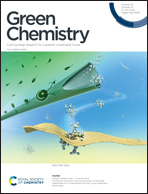Ionically conducting inorganic binders: a paradigm shift in electrochemical energy storage†
Abstract
Among the key components in batteries, binders play a vital role by interconnecting active materials and conductive additives and facilitating the coating of electrode materials on the desired substrates thus enabling the flexible fabrication of batteries. Further, they aid in buffering volume changes that arise in electrode materials and enhance their cycling stability. Presently, polyvinylidene fluoride-based binders are employed widely, despite their high cost, non-eco-friendliness, and energy inefficiency. Several water processable binders have been investigated as alternatives, but they suffer from various intrinsic issues. Here, we reveal the potential of several ionically conducting inorganic binders (ICIBs). These ICIBs are not only ionically conducting, but also water processable, chemically compatible, eco-friendly, low-cost, thermally stable (>1000 °C), emission-free, and importantly, safe to use. These inorganic binders outperformed standard polyvinylidene fluoride-based binders in several aspects. Surprisingly, ICIBs are absorbing the exothermic heat evolved by charged cathode materials at high temperatures, which will significantly enhance the safety of the batteries. The unique intrinsic ionic conductive properties combined with binding abilities enabled the flexible processing and functioning of solid-state batteries, otherwise challenging due to the mechanical rigidity, chemical incompatibility, and interfacial issues posed by solid electrolytes. The inorganic binders introduced here will make battery manufacturing and recycling more energy-efficient, eco-friendly, flexible, safe, and above all, cost-effective.



 Please wait while we load your content...
Please wait while we load your content...